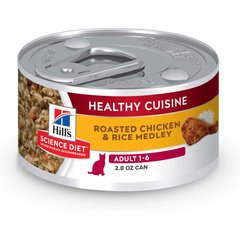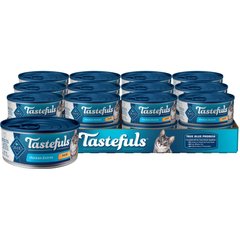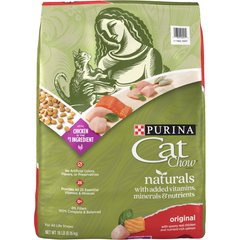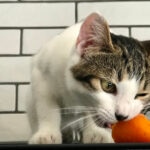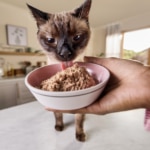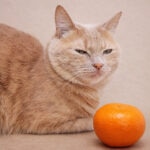The Benefits of Mixing Wet and Dry Cat Food

Photo by Alberto Gagliardi via iStock / Getty Images Plus
Does your feline seem to have a strong opinion about her food? She loves it one day, but the next day won’t even look at it?
You’re not alone. Cats can be notoriously finicky eaters, making it harder to find the right options that provide a healthy, balanced diet they will consistently devour. This can be especially true for senior cats.
If this sounds familiar, you might consider mixing wet and dry cat foods together at meal time.
Besides increasing palatability, it turns out there are some potential health benefits to feeding a combination diet. Read on to find out when and how it makes sense to transition your cat to a mixed diet. As always, if you have questions about your cat’s feeding, your vet is a great resource.
Recommended Products
Reasons To Mix Wet and Dry Cat Food
Mixing wet and dry cat food is different than adding a topper, which is often used to aid in weight gain or boost certain nutrients. Instead, cat parents and their vets combine wet and dry foods for more practical reasons, such as increasing palatability and improving appetite.
Pros and Cons of Wet Food
Cats do not always drink enough water. Dehydration can lead to health problems, including kidney or urinary tract issues. This is where wet food can help.
According to Cornell’s Feline Health Center, wet cat food from a can is typically at least 75 percent water. Food labeled semi-moist is around 35 percent water. By contrast, dry cat food is 10–12 percent water. As a result, adding wet food to your existing dry food is a great way to increase your cat’s water intake.
Wet food is also highly palatable for most cats. Wet food features highly fragrant meat that has been combined with tasty ingredients and cooked in the can, much like canned tuna from the grocery store. And because it has so much extra water weight, cats feel full faster when they eat wet food. This can help with weight control, since they eat fewer calories overall.
On the downside, wet food tends to be more expensive and is harder to store once it’s been opened.
Pros and Cons of Dry Food
Dry cat food is made through a process similar to dry dog food: a variety of ingredients are combined, then extruded, cooked, and dried into pieces or chunks of kibble.
One of the major advantages to dry food is the cost—it is usually less expensive per ounce than wet food (although this depends somewhat on the brand of food you choose).
With its crunchy kibble, dry cat food also provides dental benefits. Some options have been formulated specifically to support dental health in cats. These include Royal Canin Dental Dentaire and Hill’s Science Diet Adult Oral Care Chicken Recipe. Foods like these have been designed to help clean teeth and reduce tartar and plaque. That said, however, a dental formula is not a replacement for regular tooth cleaning and dental checkups at the vet.
Finally, dry food is also easier to store and lasts longer than wet food once it’s opened. This makes it a good choice for leaving out during the day for cats who like to graze.
Recommended Products
How To Mix Wet and Dry Cat Food
Combining wet and dry food gives you the best of both worlds. You get the palatability and hydration of wet food, along with the cost savings and dental benefits of dry food. The key to getting the maximum benefit, however, is to use the right ratio of wet to dry food.
The Best Ratio for Mixing Wet and Dry Cat Food
A basic rule of thumb is to combine 70% dry food with 30% wet, although some very wet foods may do better with a ratio of 75% dry and 25% wet.
The ideal ratio also may depend on your cat’s needs. An older cat might need extra wet food, for example, to get more hydration and entice them to keep eating. Your vet can help you determine the right ratio for your fur baby.
Tips for Gradual Transition To Mixed Feeding
If your cat is not used to mixed food, it’s important to make the change slowly. Start by adding a smaller amount of wet food to the dry food and give your cat a day or two to get used to it. Then over the next week, gradually add more wet food until you reach the target ratio.
Patience is key! Cats can be picky eaters, so your cat may need some time to get used to the new combo food. Transitioning slowly also helps prevent stomach upset.
Common Mistakes To Avoid When Mixing
Transitioning to mixed feeding isn’t complicated, but there are a few tips to make it go more smoothly:
- Don’t leave wet food out too long. Wet food can spoil quickly, so it’s best to pick up uneaten food after 30 minutes. If you have leftover wet food still in the can, store it in the refrigerator.
- Avoid overfeeding. Make sure you measure both wet and dry food to avoid giving your cat too many calories. Dry food is more calorically dense than wet food, so overweight or obese cats may need a smaller percentage of dry food.
- Don’t mix food your cat doesn’t like. If they reject a certain food, try a different flavor or brand. Mixing food is not an invitation to trick your cat into eating food she doesn’t like.
Frequently Asked Questions
Q: Can I mix different dry cat foods?
A: Yes, you can mix different dry cat foods, but it’s important to make sure they are both high-quality and meet your cat’s nutritional needs. Some cats enjoy variety, and mixing dry foods can keep mealtime interesting. Just remember to introduce new food slowly to avoid upsetting your cat’s stomach.
Q: Is it okay to mix wet and dry food in one bowl?
A: Yes, “mixed feeding” usually refers to the practice of combining both dry and wet food in the same bowl. However, you should only mix enough for one meal and remove any uneaten food after 30 minutes to keep it fresh.
Q: What if your cat rejects mixed food?
A: If your cat doesn’t like mixed food, don’t worry! Cats can be picky, so try a different approach:
- Change the ratio of wet to dry food.
- Warm up the wet food slightly to bring out the smell.
- Experiment with different flavors or brands.
It might take some time, but with a little patience, most cats will adjust to mixed feeding.
Q: Can I alternate wet and dry cat foods?
A: Yes, it’s perfectly acceptable to alternate between wet and dry foods, as long as your cat will eat both. In fact, some cats seem to prefer crunching away on dry food on its own, while still benefiting from the higher-hydration wet food. Ultimately, this will depend on your cat’s preference and your vet’s advice.
